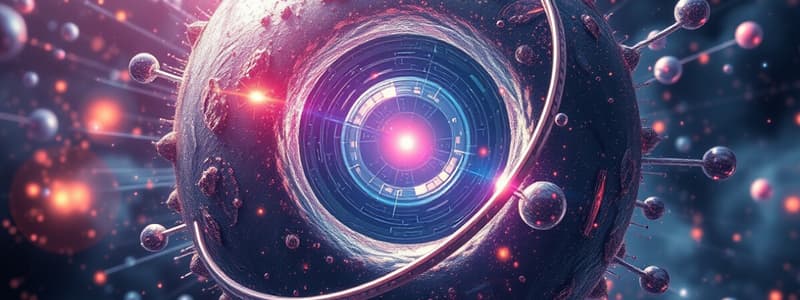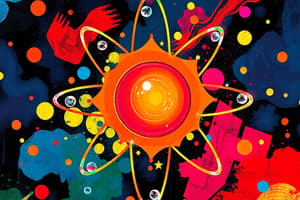Podcast
Questions and Answers
What determines the element of an atom?
What determines the element of an atom?
- The number of neutrons
- The number of protons (correct)
- The mass of the atom
- The number of electrons
Which of the following describes ionic bonds?
Which of the following describes ionic bonds?
- Atoms share electrons
- Atoms attract due to magnetic forces
- Atoms transfer electrons (correct)
- Atoms have no interaction
What state of matter is characterized by atoms that are far apart and move randomly?
What state of matter is characterized by atoms that are far apart and move randomly?
- Gas (correct)
- Plasma
- Liquid
- Solid
Which of these is a characteristic of pure substances?
Which of these is a characteristic of pure substances?
What is the smallest unit of a compound that retains its properties?
What is the smallest unit of a compound that retains its properties?
What type of particles are protons?
What type of particles are protons?
Which statement about electrons is true?
Which statement about electrons is true?
How are mixtures classified compared to pure substances?
How are mixtures classified compared to pure substances?
What characterizes ionic bonds?
What characterizes ionic bonds?
What is true about solid matter?
What is true about solid matter?
Which of the following correctly describes pure substances?
Which of the following correctly describes pure substances?
What is the main function of protons within an atom?
What is the main function of protons within an atom?
What does the atomic number of an atom represent?
What does the atomic number of an atom represent?
How are electron shells structured in an atom?
How are electron shells structured in an atom?
What happens to the number of neutrons in different isotopes of the same element?
What happens to the number of neutrons in different isotopes of the same element?
Which characteristic is true of gases compared to liquids and solids?
Which characteristic is true of gases compared to liquids and solids?
What is the trend observed in the oxides of Period 3 elements?
What is the trend observed in the oxides of Period 3 elements?
Which oxide is classified as amphoteric in Period 3?
Which oxide is classified as amphoteric in Period 3?
How is the valency of an atom determined?
How is the valency of an atom determined?
What does valency indicate regarding an atom?
What does valency indicate regarding an atom?
Which of the following is an example of a divalent atom?
Which of the following is an example of a divalent atom?
In terms of reactivity, how does valency affect an element?
In terms of reactivity, how does valency affect an element?
Which valency type describes an atom that can form three bonds?
Which valency type describes an atom that can form three bonds?
Why is understanding valency crucial in chemistry?
Why is understanding valency crucial in chemistry?
What is the role of valency in chemistry?
What is the role of valency in chemistry?
Which of the following statements accurately describes polyatomic ions?
Which of the following statements accurately describes polyatomic ions?
Which of the following is a common polyatomic ion?
Which of the following is a common polyatomic ion?
How is the charge on a polyatomic ion determined?
How is the charge on a polyatomic ion determined?
What distinguishes polyatomic ions from free radicals?
What distinguishes polyatomic ions from free radicals?
Which of the following represents a polyatomic ion with a negative charge?
Which of the following represents a polyatomic ion with a negative charge?
Which statement is true about the behavior of atoms in polyatomic ions?
Which statement is true about the behavior of atoms in polyatomic ions?
Which of the following describes the composition of polyatomic ions?
Which of the following describes the composition of polyatomic ions?
Which property is characteristic of metals?
Which property is characteristic of metals?
What is an example of a non-metal?
What is an example of a non-metal?
Which of the following is a property of metalloids?
Which of the following is a property of metalloids?
At what temperature does silicon melt?
At what temperature does silicon melt?
Which industry heavily utilizes silicon due to its semiconducting properties?
Which industry heavily utilizes silicon due to its semiconducting properties?
What is a characteristic property of boron?
What is a characteristic property of boron?
Which of the following is NOT a use of silicon?
Which of the following is NOT a use of silicon?
How does amorphous boron typically react under high temperatures?
How does amorphous boron typically react under high temperatures?
Flashcards are hidden until you start studying
Study Notes
Structure of Matter
- Matter is composed of tiny particles called atoms, the fundamental building blocks of substances.
- Atoms contain three main subatomic particles: protons (positively charged), neutrons (neutral), and electrons (negatively charged).
- The identity of an atom is determined by the number of protons; for example, an atom with 6 protons is carbon, while 8 protons indicate oxygen.
Molecules and Bonds
- Atoms combine to form molecules, the smallest units of compounds retaining properties of those compounds.
- Covalent bonds occur when atoms share electrons, while ionic bonds occur when electrons are transferred, creating charged ions.
States of Matter
- The three fundamental states are:
- Solid: Atoms are closely packed and vibrate in fixed positions.
- Liquid: Atoms are close together but move around each other, maintaining a definite volume while taking the shape of their container.
- Gas: Atoms are far apart and move randomly, having neither a definite shape nor volume.
Classifications of Matter
- Pure Substances: Uniform composition consisting of one type of atom or molecule (e.g., elements like gold and compounds like water).
- Mixtures: Consist of two or more substances physically combined (e.g., air and salad).
Atomic Structure
- The nucleus is the dense core containing protons (which determine the element) and neutrons (that contribute to atomic mass).
- Electron shells contain electrons that orbit the nucleus; their quantity equals the number of protons in a neutral atom.
Atomic Number and Mass
- Atomic number refers to the number of protons, while mass number is the sum of protons and neutrons.
- Elements can have the same atomic number but different mass numbers due to varying neutrons.
Classification Relationships
- Metals: Shiny, good conductors, malleable (e.g., Iron, Copper).
- Non-Metals: Dull, poor conductors, brittle (e.g., Oxygen, Carbon).
- Metalloids: Have intermediate properties; act as semiconductors (e.g., Silicon).
Properties of Silicon
- Second most abundant element in the Earth's crust, found in crystalline and amorphous forms.
- Melting point is 1,410°C; used primarily in electronics (transistors and diodes), solar cells, and computer equipment.
Properties of Boron
- Black, crystalline solid with a high melting point of 2,200°C and relatively low reactivity.
- Reacts only at very high temperatures with some substances, forming various compounds.
Chemical Formulae
- A chemical formula represents the composition of a compound using element symbols and numerical subscripts.
- Valency reflects an atom's bonding capacity, based on the number of electrons in the outer shell.
Types of Valency
- Monovalent: One bond (e.g., Hydrogen).
- Divalent: Two bonds (e.g., Oxygen).
- Trivalent: Three bonds (e.g., Nitrogen).
- Quadrivalent: Four bonds (e.g., Carbon).
Polyatomic Ions
- Groups of atoms bonded together that carry an overall charge; behave as a single unit in reactions.
- Examples include Nitrate (NO₃⁻), Sulfate (SO₄²⁻), Phosphate (PO₄³⁻), and Ammonium (NH₄⁺).
Summary of Trends in Periodic Elements
- The oxides of Period 3 elements show a trend from basicity to acidity, transitioning from sodium to chlorine, with aluminum oxide acting as amphoteric.
Importance of Understanding Structure of Matter
- Knowledge of atomic and molecular structures is fundamental in explaining material properties, behavior in reactions, and applications in chemistry, materials science, and physics.
Studying That Suits You
Use AI to generate personalized quizzes and flashcards to suit your learning preferences.




